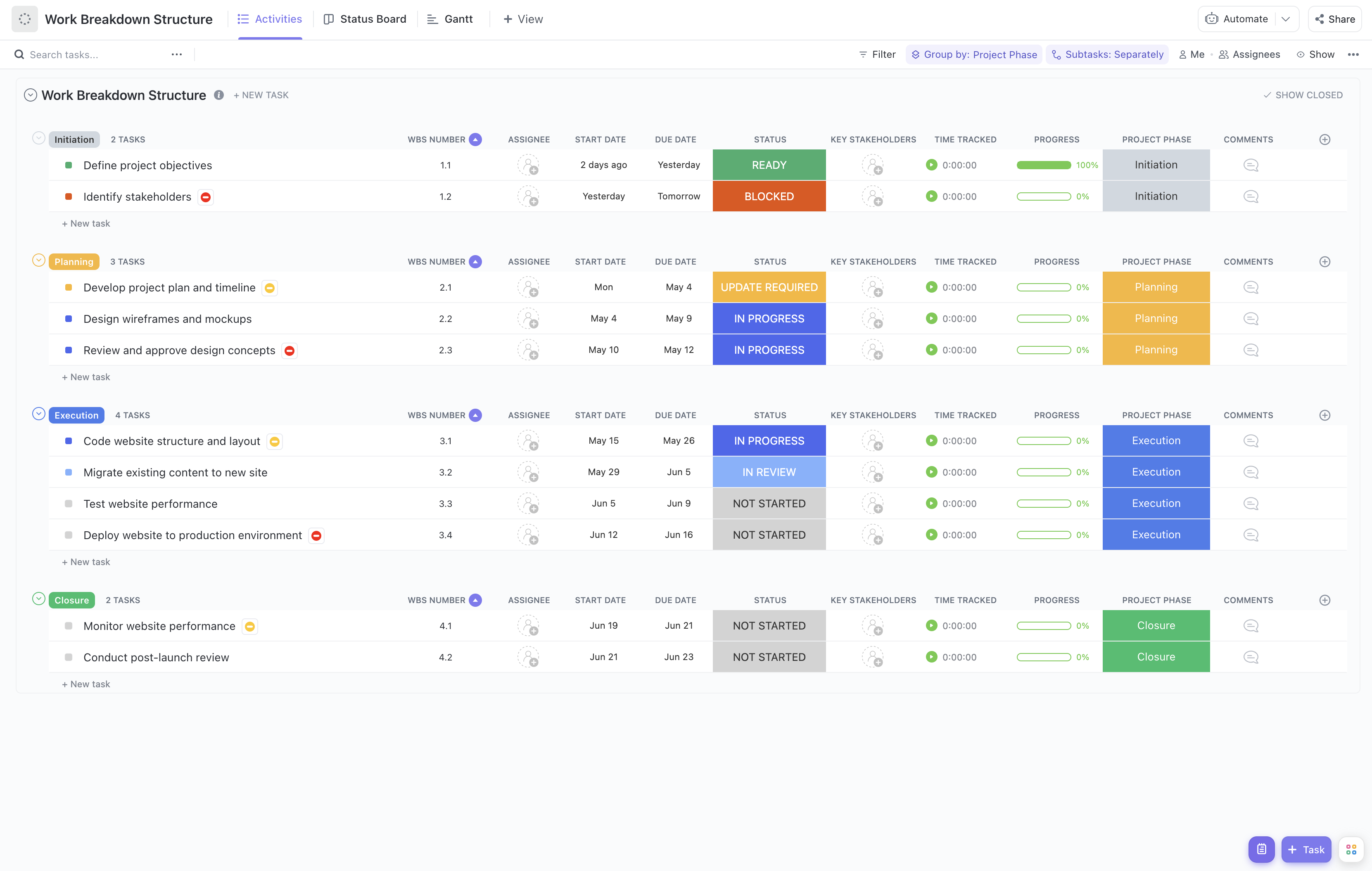Implementing new software can be a complex and daunting task, but with ClickUp's Software Implementation Work Breakdown Structure Template, the process becomes a breeze. This template provides a step-by-step breakdown of all the tasks and activities involved in implementing new software, ensuring that nothing falls through the cracks.
With ClickUp's Software Implementation WBS Template, you can:
- Define clear and actionable tasks for each phase of the implementation process
- Assign responsibilities to team members and track progress in real-time
- Identify potential risks and develop mitigation strategies to ensure a smooth implementation
- Streamline communication and collaboration among stakeholders for better alignment
Whether you're implementing a new CRM system or an enterprise-level software, ClickUp's template has got you covered. Start your software implementation journey with confidence and get things done efficiently with ClickUp!
Benefits of Software Implementation Work Breakdown Structure Template
Implementing new software can be a complex process, but with the Software Implementation Work Breakdown Structure Template, you can streamline the entire journey. Here are some benefits of using this template:
- Clearly define project scope and objectives
- Break down the implementation process into manageable tasks
- Assign responsibilities to team members and track progress
- Identify potential risks and develop mitigation strategies
- Ensure effective communication and collaboration among team members
- Stay on schedule and meet project deadlines
- Improve overall project efficiency and success rate
Main Elements of Software Implementation Work Breakdown Structure Template
ClickUp's Software Implementation Work Breakdown Structure template is designed to help you efficiently manage and track the progress of your software implementation projects. Here are the main elements of this template:
- Custom Statuses: Keep track of the different stages of your software implementation project with 6 custom statuses, including Open, Cancelled, Complete, Delayed, In Progress, and Needs Input.
- Custom Fields: Utilize 9 custom fields such as Project Phase, Allocated Budget, Consulted, Progress, Remaining Effort Hours, Responsible, Accountable, Cost Type, and Informed to capture and organize important information about each task or activity within your project.
- Custom Views: Access 5 different views to gain different perspectives on your software implementation project, including Activities List View, Status List View, Gantt Chart View, Getting Started Guide, and Timeline View.
- Project Management: Leverage ClickUp's powerful project management features such as task dependencies, time tracking, collaboration tools, and integrations to streamline your software implementation process and ensure successful project completion.
How to Use Work Breakdown Structure for Software Implementation
Implementing new software can be a complex process, but with the Software Implementation Work Breakdown Structure (WBS) template in ClickUp, you can break it down into manageable steps. Here's how to use the template effectively:
1. Define project scope and objectives
Before diving into the software implementation process, it's crucial to clearly define the scope and objectives of the project. This includes identifying the specific features and functionalities you want to implement, as well as any constraints or limitations.
Use the Goals feature in ClickUp to set clear project objectives and ensure that everyone is on the same page.
2. Break down tasks and subtasks
Once you have a clear understanding of the project scope, it's time to break down the implementation process into smaller tasks and subtasks. This will help you organize and prioritize the work, making it easier to allocate resources and track progress.
Use the Gantt chart in ClickUp to create a visual representation of the project timeline and break down tasks into manageable chunks.
3. Assign responsibilities and deadlines
To ensure a smooth software implementation process, it's essential to assign responsibilities and set deadlines for each task and subtask. This helps keep everyone accountable and ensures that the project stays on track.
Use the Board view in ClickUp to assign tasks to team members and set due dates for each task.
4. Monitor progress and make adjustments
Throughout the software implementation process, it's important to monitor progress and make adjustments as needed. Regularly review the status of each task and subtask, and address any issues or roadblocks that arise.
Use the Dashboards feature in ClickUp to track the progress of the software implementation project at a glance and quickly identify areas that need attention.
By following these steps and utilizing the Software Implementation Work Breakdown Structure template in ClickUp, you can streamline the software implementation process and ensure a successful outcome.

Get Started with ClickUp's Software Implementation Work Breakdown Structure Template
Software implementation teams can use this Software Implementation Work Breakdown Structure Template to help everyone stay on track when it comes to implementing new software in an organization.
First, hit “Get Free Solution” to sign up for ClickUp and add the template to your Workspace. Make sure you designate which Space or location in your Workspace you’d like this template applied.
Next, invite relevant members or guests to your Workspace to start collaborating.
Now you can take advantage of the full potential of this template to successfully implement new software:
- Use the Activities View to break down the implementation process into specific tasks and subtasks
- The Status View will help you easily track the progress of each task and identify any delays
- Utilize the Gantt View to visualize the project timeline and identify task dependencies
- Refer to the Getting Started Guide View to access resources and instructions for each step of the implementation process
- The Timeline View provides a comprehensive overview of the project timeline, allowing you to quickly assess progress and deadlines
- Organize tasks into six different statuses: Open, Cancelled, Complete, Delayed, In Progress, Needs Input, to track progress and identify bottlenecks
- Update statuses as tasks progress to ensure transparency and keep stakeholders informed









